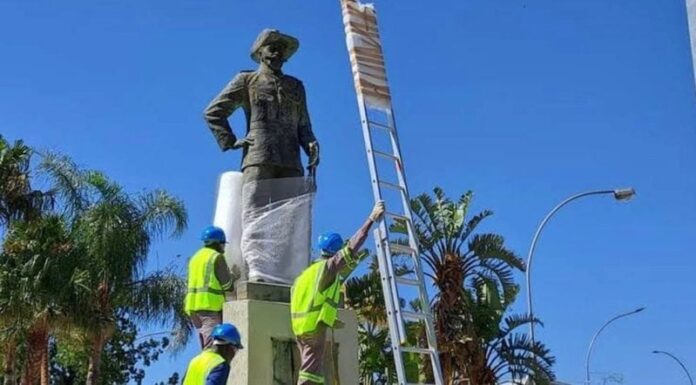Authorities in Namibia’s capital Windhoek on Wednesday took down and relocated a statue of a controversial German colonial officer following pressure from local activists.
The monument commemorated Curt von Francois, a German army commissioner who has been credited with founding Windhoek-something local campaigners and historians dispute.
The statue, which stood on a high pedestal outside municipal buildings, depicted Von Francois in a military uniform with a moustache, a large hat, and holding a sword.
Early in the 20th Century Namibia was a German Colony. After the 1st World War it became a League of Nations administered territory. Following the 2nd World War, South Africa administered Namibia, until independence in 1990. Namibia has passed through several distinct stages over the years.
“This moment is a recollection of dignity, our city has been white-washed,” Hildegard Titus, an activist with the A Curt Farewell movement that pushed for the statue’s removal, told AFP. “There is an emotional tie to the statue being taken down but it also has to do with historical accuracy.”
The city council said the statue, which A Curt Farewell described as “a reminder of genocide,” will now be kept at the Windhoek City Museum.
There it will be displayed with an explanation of the historical context, said Aaron Nambadi, a curator at the museum.
“We as historians and curators were involved in this project to correct the false narrative that Von Francois was the founder of the city,” Nambadi told AFP.
2015: Negotiations start between the Namibian and German governments over an official apology and aid money.
July 7, 2016: For the first time, the German government recognizes the mass murder of Herero and Nama by German troops as genocide in an official document.
May 28, 2021: After six years of negotiations, German Foreign Minister Heiko Maas announces an agreement has been reached in which Germany recognizes the atrocities committed against the Herero and Nama people in the early 1900s as genocide. Berlin pledges to spend €1.1 billion ($1.3 billion) over 30 years for infrastructure and development aid in Namibia. The payments do not include reparations and are derided by Herero and Nama leaders as “unacceptable.”
Germany colonized Namibia from 1884 to 1915. Between 1904 and 1908, German settlers killed tens of thousands of indigenous Herero and Nama people in massacres historians have called the 20th century’s first genocide.














